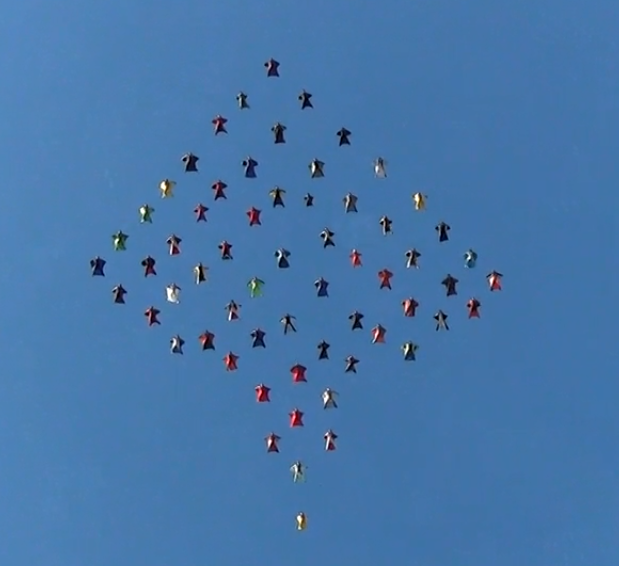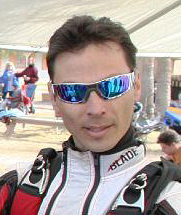Recommended Posts
Your question ( although hypothetical) has to be looked at as not rapid decompression in an aircraft, because that opens up a whole new ballgame. If for example, a guy has a face mask and is breathing pure oxygen from a supply on board,, and then at an open door he jumps, he likely could make it to enough ambient air to breath. If however, he is breathing an air mixture inside the aircraft, there would have to be rapid decompression to get the door open, and the scenario changes bigtime.
prolonged breathing with
a face mask, he could have body saturation, and there would be enough oxygen in his blood to make it to a lower altitude, but there would be no saturation breathing the air mixture supplied in a pressureized aircraft...likely giving him a problem.
However, his biggest problem would come from the rapid decompression of the aircraft, with additional problems once he got out....IF he got out. Bill Cole
prolonged breathing with
a face mask, he could have body saturation, and there would be enough oxygen in his blood to make it to a lower altitude, but there would be no saturation breathing the air mixture supplied in a pressureized aircraft...likely giving him a problem.
However, his biggest problem would come from the rapid decompression of the aircraft, with additional problems once he got out....IF he got out. Bill Cole
neilly 0
OK let me define the question, If the plane did suddenly decompress, And I survived, the initial shock of that, Would it be possible to go head down and get to a "safe" altitude to deploy my chute, lets say 15,000 ft , cos I dont want hypoxia.
Or am I going to get into difficulty just cos of the pressure differential? when the plane decompresses?
No oxygen saturation , just having a glass of wine, and some wally opens the door, and I have my chute near me, and can put it on, like I am a 13 yr old gymnast ,
Well you know stranger things have happened,
Or am I going to get into difficulty just cos of the pressure differential? when the plane decompresses?
No oxygen saturation , just having a glass of wine, and some wally opens the door, and I have my chute near me, and can put it on, like I am a 13 yr old gymnast ,
Well you know stranger things have happened,
Fly like an aardvark
with the scenario that you paint, wine, decompression, putting the chute on during decompression etc etc....I doubt very much you'd survive. I love a scenario with a risk, even an added risk, if I can plan it, but I wouldnt want to be part of your scenario at all. You have too many things against you before you begin. Bill Cole
darkwing 5
I'll give you a 15% chance.
-- Jeff
My Skydiving History
-- Jeff
My Skydiving History
dterrick 0
Hey Neil,
interesting scenario but I'd agree with Bill that you propose TOO many variables to predict any success. Frankly, having watched most of the movies with bad and/or unrealistic skydiving scenes in them, Hollywood makes it appear possible.
'Wally' would likely never get the door open. If he did, decompression would be only one problem - the 5-600 mph wind blast would be quite another. If, and only if, you weren't torn apart or your rig torn from your body at those 'jumprun' speeds you're likely still a minute away from functionally useful air.
More likely, the pilot would see his little "door ajar" light and dive the plane till the wings broke off. He'd beat you to good air and you'd have much less chance of getting sucked into the engine.
Now, once the plane got down to a couple hundred mph and maybe 15,000 ft or so, I'd say "DB cooper already did that" but it's not been done since
...except at WFFC when they bring the 727 and "everybody does it".
-Dave
PS: Bill Cole's done some 'strange' things involving parachutes ... trust him on this one
Life is very short and there's no time for fussing and fighting my friend (Lennon/McCartney)
interesting scenario but I'd agree with Bill that you propose TOO many variables to predict any success. Frankly, having watched most of the movies with bad and/or unrealistic skydiving scenes in them, Hollywood makes it appear possible.
'Wally' would likely never get the door open. If he did, decompression would be only one problem - the 5-600 mph wind blast would be quite another. If, and only if, you weren't torn apart or your rig torn from your body at those 'jumprun' speeds you're likely still a minute away from functionally useful air.
More likely, the pilot would see his little "door ajar" light and dive the plane till the wings broke off. He'd beat you to good air and you'd have much less chance of getting sucked into the engine.
Now, once the plane got down to a couple hundred mph and maybe 15,000 ft or so, I'd say "DB cooper already did that" but it's not been done since
...except at WFFC when they bring the 727 and "everybody does it".
-Dave
PS: Bill Cole's done some 'strange' things involving parachutes ... trust him on this one
Life is very short and there's no time for fussing and fighting my friend (Lennon/McCartney)
Without EVEN wanting to rehash all the REAL WORLD variables involved with High altitude jumping that I've posted in the safety forum I will just say that this "scenario" is a typical hollywood one. With that said, I will provide a link to an old but good early account of high altitude jumping and the difficulties involved. CLICK ME
"It's just skydiving..additional drama is not required"
Some people dream about flying, I live my dream
SKYMONKEY PUBLISHING
Some people dream about flying, I live my dream
SKYMONKEY PUBLISHING
Although I'm far, far away from being able to do a 30,000 foot jump this topic has always caught my interest. I'm always interested in the boundaries of the human body and oxygen deprevation is one of them.
My old man once held his breath for 3:00 on a bet in high school. He was a distance runner. I took this as a challenge around 16 years of age and hit 2:37. At the age of 18 I managed to hit 4:39 without breathing. I was loopy after that for a while -- I'll give you that. Now that I'm out of shape I can still do 3:00 because I'm accustomed to it I guess. I have no idea if this is a damned weird situation or not. I don't know anybody else that can do it personally but I know they're out there.
Around the era that I could hit 4:00 or higher consitently I was in Arizona at the Grand Canyon around 7,000 ASL and could run around and such with little difficulty.
Everest can be nailed without O2 from what I know and that's at 30,000 feet plus. Can't the same be done with skydiving? Granted, the percentage of skydivers capable of such things is probably a lower percentage than that of mountain climbers can but is there any real threat to a properly trained human being with good 02 utilization going out at 30,000 and having to wait 2:00 until they get to somewhat normal O2 saturation levels?
I admit I approach the subject from the wrong schooling. To hold your breath the key is not to saturate with 02 bur rather to breathe in preperation to deplete your blood stream of CO2. Your brain senses C02 levels to tell you when you're in trouble. Breathing hard does little to saturate your blood stream with 02 but very much to get out all the C02 that will turn on your instincts to breathe.
Do the two situations relate at all or is there something I'm missing?
My old man once held his breath for 3:00 on a bet in high school. He was a distance runner. I took this as a challenge around 16 years of age and hit 2:37. At the age of 18 I managed to hit 4:39 without breathing. I was loopy after that for a while -- I'll give you that. Now that I'm out of shape I can still do 3:00 because I'm accustomed to it I guess. I have no idea if this is a damned weird situation or not. I don't know anybody else that can do it personally but I know they're out there.
Around the era that I could hit 4:00 or higher consitently I was in Arizona at the Grand Canyon around 7,000 ASL and could run around and such with little difficulty.
Everest can be nailed without O2 from what I know and that's at 30,000 feet plus. Can't the same be done with skydiving? Granted, the percentage of skydivers capable of such things is probably a lower percentage than that of mountain climbers can but is there any real threat to a properly trained human being with good 02 utilization going out at 30,000 and having to wait 2:00 until they get to somewhat normal O2 saturation levels?
I admit I approach the subject from the wrong schooling. To hold your breath the key is not to saturate with 02 bur rather to breathe in preperation to deplete your blood stream of CO2. Your brain senses C02 levels to tell you when you're in trouble. Breathing hard does little to saturate your blood stream with 02 but very much to get out all the C02 that will turn on your instincts to breathe.
Do the two situations relate at all or is there something I'm missing?
QuoteEverest can be nailed without O2 from what I know and that's at 30,000 feet plus. Can't the same be done with skydiving?
Kind of like comparing apples and oranges if you ask me. Climbers aclimatize to their altitude over a very long period of time so that they can function up high, there is a physiological change in the body's ability to utilize O2. Even then summit attempts are quick to return back down as the health risks go up exponentially when at that altitude. Skydivers have absolutely no aclimatization period and are generally rapidly asending and decending which is why the bends and other physical ailments come into play.
"It's just skydiving..additional drama is not required"
Some people dream about flying, I live my dream
SKYMONKEY PUBLISHING
Some people dream about flying, I live my dream
SKYMONKEY PUBLISHING
In 1975 and again in 1977, I was training the Brigade of Special Forces in Ecuador, South America. The first time I stayed in the Capital city of Quito, which is 9500 ft above sealevel. I was starved of oxygen for the whole two weeks that I was there, and could hardly move.
I was able to lift my gear and get it on my back, but didnt have the strength to do up the snaps unless I gasped for some air for about 30 seconds.
After finally getting my gear on, I would slowly walk to the aircraft, an Israeli Arava, which looked like a small cigar with twin tail booms. I would then ( with great effort) climb on board, and off we would go to climb another 7500 ft higher.
For a 30 second freefall, we were jumping from17000 feet above sealevel, and this after living at 9500 feet, when we were not jumping.
I couldnt breathe on the ground, and gasped for air almost all the time. The city is built on hills, and to walk anywhere, it was a real job to climb the hills.
As we came in on jumprun, my interpreter Eduardo, would be running back and forth in the aircraft, giving the soldiers his last minute instructions. I was sitting near the door, not moving an inch.
The first stick of jumpers went out, Eduardo was sticking his head out the door, and he turned to me and said " all right on target".
In my situation, I mumbled "good for them" and waited until we had the plane again on jumprun, (Eduardo spotting) and when he said "Salto" I would get up, wheel around and fall out of the plane.
In freefall, it was like jumping at home, no problem, I would do all I had to do, and when I dumped, I would be back in the real world, unable to breathe
again. I would fly my chute to whereever the target was, and huff and puff after landing, gasping for air.
Eduardo was so accustomed to the thin air, he and the others had no problems..their bodies were used to it....I was dead on my feet, but wouldnt lie down. Lying down took to much energy...which I didnt have.
The next time (1977) I had them do the jumping on the coast of Ecuador at Salinas, and between jumps I could stick my feet in the Pacific ocean. No breathing problems...but massive bacteria in the drinking water...Boy, was I sick and dehydrated when I finally got back to Toronto...4 days in hospital.
I have had 7 or 8 HAI courses (High Altitude Indoctrination), and each time was in a decompression chamber, to 35,000 or as high as 43,000 ft.
At 30K +, we were told to remove our oxygen masks, and given tests to perform. We ended up trying to put square pegs in round holes, writing our name was nothing more than a scribble, not resembling any letters of the alphabet...just a scribble. We were given items to hang on a board of hooks in designated places, and failed them all.
Once the mask was put back on our faces, we were fine, and it wasnt off for more than 1 minute for the test.The effects of hypoxia set in fast.
When I jumped from 36,916 ft, I prebreathed for 20 minutes before the aircraft even took off to help purge the nitrogen from my body. I continued to breathe ( demand regulator) until jumprun, and then I unhooked the console supply of oxygen and went on my bailout bottle, which is 2000 lbs of oxygen pressure, forcing it into my lungs.
This pressure reduces as the oxygen is used, and I come into the ambient air at 25,000 feet when the ground rush begins.I had a sensitive altimeter and a non sensitive altimeter and a stopwatch. The ground rush at that altitude is like jumping from 3000 feet and being at 500 feet.
It is necessary to forcibly exhale during the use of the bailout bottle, because you are exhaling against the 2000 lbs pressure.
The scenario of Neilly, is strictly HOLLYWOOD, and not in the least realistic.
It is akin to putting 6 bullets in a revolver including one blank, and then playing Russian Roulette..hoping to get that one blank.
Lack of oxygen in freefall at heights of 30,000 plus is no joke.
One last thing. During the first Gulf War, two Brit air crew ejecfted from their disabled jet, and were taken prisoner. Their photos were put on the front page of every newspaper, their faces black and blue. It declared that the Iraqis had beaten them.
When I saw the photos, I knew immediately the black and blue faces were from the ejection blast into the air. Its like being hit with a 2 X 4. Later, the news reports admitted that was the case.
One cannot leave an aircraft travelling at extremely high speeds without suffering some damage, especially to exposed parts of their bodies ( i.e. faces).
Neilly....tell your friend it just wouldnt work as your original scenario was put forth., Bill Cole D-41 Canada
I was able to lift my gear and get it on my back, but didnt have the strength to do up the snaps unless I gasped for some air for about 30 seconds.
After finally getting my gear on, I would slowly walk to the aircraft, an Israeli Arava, which looked like a small cigar with twin tail booms. I would then ( with great effort) climb on board, and off we would go to climb another 7500 ft higher.
For a 30 second freefall, we were jumping from17000 feet above sealevel, and this after living at 9500 feet, when we were not jumping.
I couldnt breathe on the ground, and gasped for air almost all the time. The city is built on hills, and to walk anywhere, it was a real job to climb the hills.
As we came in on jumprun, my interpreter Eduardo, would be running back and forth in the aircraft, giving the soldiers his last minute instructions. I was sitting near the door, not moving an inch.
The first stick of jumpers went out, Eduardo was sticking his head out the door, and he turned to me and said " all right on target".
In my situation, I mumbled "good for them" and waited until we had the plane again on jumprun, (Eduardo spotting) and when he said "Salto" I would get up, wheel around and fall out of the plane.
In freefall, it was like jumping at home, no problem, I would do all I had to do, and when I dumped, I would be back in the real world, unable to breathe
again. I would fly my chute to whereever the target was, and huff and puff after landing, gasping for air.
Eduardo was so accustomed to the thin air, he and the others had no problems..their bodies were used to it....I was dead on my feet, but wouldnt lie down. Lying down took to much energy...which I didnt have.
The next time (1977) I had them do the jumping on the coast of Ecuador at Salinas, and between jumps I could stick my feet in the Pacific ocean. No breathing problems...but massive bacteria in the drinking water...Boy, was I sick and dehydrated when I finally got back to Toronto...4 days in hospital.
I have had 7 or 8 HAI courses (High Altitude Indoctrination), and each time was in a decompression chamber, to 35,000 or as high as 43,000 ft.
At 30K +, we were told to remove our oxygen masks, and given tests to perform. We ended up trying to put square pegs in round holes, writing our name was nothing more than a scribble, not resembling any letters of the alphabet...just a scribble. We were given items to hang on a board of hooks in designated places, and failed them all.
Once the mask was put back on our faces, we were fine, and it wasnt off for more than 1 minute for the test.The effects of hypoxia set in fast.
When I jumped from 36,916 ft, I prebreathed for 20 minutes before the aircraft even took off to help purge the nitrogen from my body. I continued to breathe ( demand regulator) until jumprun, and then I unhooked the console supply of oxygen and went on my bailout bottle, which is 2000 lbs of oxygen pressure, forcing it into my lungs.
This pressure reduces as the oxygen is used, and I come into the ambient air at 25,000 feet when the ground rush begins.I had a sensitive altimeter and a non sensitive altimeter and a stopwatch. The ground rush at that altitude is like jumping from 3000 feet and being at 500 feet.
It is necessary to forcibly exhale during the use of the bailout bottle, because you are exhaling against the 2000 lbs pressure.
The scenario of Neilly, is strictly HOLLYWOOD, and not in the least realistic.
It is akin to putting 6 bullets in a revolver including one blank, and then playing Russian Roulette..hoping to get that one blank.
Lack of oxygen in freefall at heights of 30,000 plus is no joke.
One last thing. During the first Gulf War, two Brit air crew ejecfted from their disabled jet, and were taken prisoner. Their photos were put on the front page of every newspaper, their faces black and blue. It declared that the Iraqis had beaten them.
When I saw the photos, I knew immediately the black and blue faces were from the ejection blast into the air. Its like being hit with a 2 X 4. Later, the news reports admitted that was the case.
One cannot leave an aircraft travelling at extremely high speeds without suffering some damage, especially to exposed parts of their bodies ( i.e. faces).
Neilly....tell your friend it just wouldnt work as your original scenario was put forth., Bill Cole D-41 Canada
LOL. Small world. I too have been to both of those locations in Ecuador. I had no problems in Quito but I thought salinas was too damn hot and humid. I also was able to climb Mt. Cotipoxi while I was there with Los Alpinistas de las fuerzas Especiales. I'm sure not much has really changed since you were there, it's pretty much the same just more people and buildings.

"It's just skydiving..additional drama is not required"
Some people dream about flying, I live my dream
SKYMONKEY PUBLISHING
Some people dream about flying, I live my dream
SKYMONKEY PUBLISHING
dterrick 0
Nice weblink Lou!
Between the real world tales from those of you sharing and the links I've followed, this has been one of the most entertaining and enlightening threads I've followed in a long while.
Neil (neilly), please let your friend know that he has helped bring out some very valuable discussions quite by accident and we're all better for it ... and that he would almost certainly enjoy the chance to get 'sucked out' at 3,000 ft on a a static line


This place is great!
-Dave
Life is very short and there's no time for fussing and fighting my friend (Lennon/McCartney)
Between the real world tales from those of you sharing and the links I've followed, this has been one of the most entertaining and enlightening threads I've followed in a long while.
Neil (neilly), please let your friend know that he has helped bring out some very valuable discussions quite by accident and we're all better for it ... and that he would almost certainly enjoy the chance to get 'sucked out' at 3,000 ft on a a static line
This place is great!
-Dave
Life is very short and there's no time for fussing and fighting my friend (Lennon/McCartney)
neilly 0
OK so lets get this straight, watching a wally open the door of the plane whilst sipping my glass of wine, and then calmy putting on my rig,like thats gonna happen ( screeeeeeeeeeaaammmm!!!) IS not possible cos you are gonna end up sucked outta the plane , probably getting a severe beating and discarded into the sky, DAMN ![[:/] [:/]](/uploads/emoticons/dry.png)
BUT if i did Then I have to hold my breath, again probably not possible cos of the pressure difference, and I only have 20 seconds of useful conciousness, so I am gonna black out, DOUBLE DAMN
Then i am gonna fall, But if my rig has an AAD, and its set,chance in hell? like an icecubes , then my chute is gonna open and save my life, providing I get a clean opening, and I wake up to clear the twists etc.
providing I get a clean opening, and I wake up to clear the twists etc.
Of course knowing my luck this is where I wake up to find either,
a) I am over the pacific, atlantic, a big piece of water, Cant swim, gonna sink
gonna sink
b) a nasty animal is sat below ready to receive dinner, picture lion mouth wide open,
all in all, I think the best option is to drink the wine very fast, bend over and kiss my *** goodbye,
BUt thanks to all for the useful info, it makes you realise all the things that can go wrong , and should be taken into account, if Mr Wally did open that door,
BUT if i did Then I have to hold my breath, again probably not possible cos of the pressure difference, and I only have 20 seconds of useful conciousness, so I am gonna black out, DOUBLE DAMN
Then i am gonna fall, But if my rig has an AAD, and its set,chance in hell? like an icecubes , then my chute is gonna open and save my life,
Of course knowing my luck this is where I wake up to find either,
a) I am over the pacific, atlantic, a big piece of water, Cant swim,
b) a nasty animal is sat below ready to receive dinner, picture lion mouth wide open,
all in all, I think the best option is to drink the wine very fast, bend over and kiss my *** goodbye,
BUt thanks to all for the useful info, it makes you realise all the things that can go wrong , and should be taken into account, if Mr Wally did open that door,
Fly like an aardvark
why dont you take a gun and shoot Wally...then if YOU open the door, at least u can have your rig on, and hope you make it. Good luck.
Bill Cole D-41
Bill Cole D-41
neilly 0
have you tried carrying a firearm on a passenger jet, DOH, now that would be crazy, I think I would just open the door myself and throw Mr Wally out, at least i get some fun that way, LOL 


Fly like an aardvark
sounds like a plan....or get him before takeoff and enjoy your flight.
Even if you do pass out, you might wake up before...well...before your cypres fires. 
Dave
Dave



Kevin Uliassi had his O2 regulator blow out at 30,000ft over northern India during his around-the-world balloon flight attempt in March 2000. He started an emergency descent (which is still slow in a 400,00 cu ft Rozier balloon) and stabilized at approx 22,000ft. He did not pass out. He was, however, in very good physical condition and had acclimatized to altitude over several weeks before his departure.
The only sure way to survive a canopy collision is not to have one.
Share this post
Link to post
Share on other sites